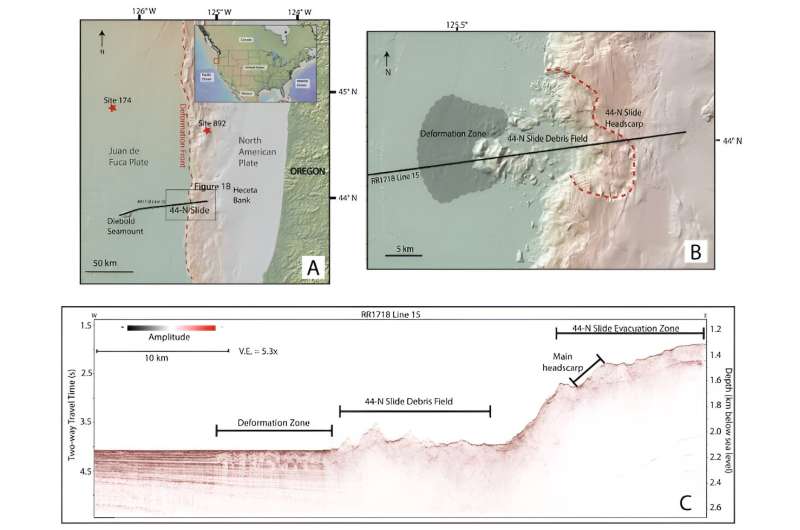This article has been reviewed according to Science X's editorial process and policies. Editors have highlighted the following attributes while ensuring the content's credibility:
fact-checked
peer-reviewed publication
trusted source
proofread
Study examines link between underwater landslides and tsunamis

Scientists have calculated a way to determine the speed of past underwater landslides. To do so, researchers from The Ohio State University studied the remains of an underwater landslide just off the coast of Oregon—dubbed the 44-N Slide—that is part of the Cascadia Subduction Zone (CSZ).
Stretching from Vancouver Island in Canada to Cape Mendocino in Northern California, the CSZ is a dipping fault line that has been the source of some of the most powerful earthquakes ever recorded. These quakes can result in underwater (also known as submarine) landslides, which can lead to tsunamis.
Now, using properties measured from distortions in the sea floor near the 44-N Slide, researchers have developed a novel approach for analyzing the risk that underwater landslides may trigger deadly tsunamis.
Previous research showed that large blocks from the 44-N Slide dropped down 1,200 meters at a 13-degree slope, and slid 10 kilometers horizontally before it finally came to a standstill. The researchers in this study investigated the shape and volume of the rock structures in the area where it was deposited, creating what's called a "deformation zone."
Their findings showed that the 44-N Slide was estimated to be moving at 60 meters per second during its fall, and impacted the sea floor with so much force that it created a 275-meter thick and 10-kilometer-long region of contorted and deformed sea floor sediment. Because of its velocity, it also likely could have been "tsunamigenic," meaning it was powerful enough to have generated a huge tsunami on its own, though it's unclear if that particular instance did.
Researchers are unsure when the 44-N Slide might have occurred.
"Just like on land, submarine landslides happen when giant masses of rock and sediment fall," said Derek Sawyer, co-author of the study and an associate professor of earth sciences at The Ohio State University. "They can be really dangerous to people if they create tsunamis, which is why we want to understand how, when and why they form."
The study was published in Geophysical Research Letters.
Despite being a relatively common occurrence, known instances of tsunamigenic slides have been extremely limited. Moreover, discerning the type of underwater landslide and whether that event could cause such a disaster can be a challenging task—mainly because researchers are only able to interpret how fast these landslides travel from the deposits they leave behind, said Sawyer.
The minimum velocity needed for an underwater landslide to trigger a tsunami is still unconfirmed, Sawyer said. One piece of evidence is the Storegga Slides, a series of landslides that occurred in the Norwegian Sea over a period of thousands of years, which were estimated to have a speed of between 35 and 60 meters per second. It caused such massive tsunamis that some scientists believed it to be responsible for washing away the land bridge between Great Britain and the rest of Europe.
The 1929 Grand Banks Earthquake also triggered underwater landslides and turbidity flows that moved between 15-30 meters per second, and caused tsunami waves so high that they destroyed a number of coastal communities. The underwater landslides themselves ripped apart underwater communication cables connecting the U.S. and Europe.
"Submarine landslides can sometimes move so fast that they cause infrastructure damage to the global internet cables that line the ocean floor, as well as trigger and even amplify earthquake-caused tsunamis," said Sawyer.
Nevertheless, both the Storegga Slides and the Grand Banks Earthquake served as a fount of knowledge for researchers striving to more closely examine the complexities behind these seismic-induced phenomena.
"Because of the timing of the cable breaks, scientists could back-calculate how fast those flows were going, which was the first time we'd ever been able to do that in the marine environment," said Sawyer. "The severity of these events, like how big the tsunami is or how dangerous it is, is tightly tied to how fast the landslide moves."
Deciphering how past landslides played out is vital, not only for protecting underwater cables, but also for people living on coastlines and policymakers who guide emergency response plans in response to tsunamis, said Sawyer.
After all, getting a better grip on the mechanics of underwater landslides could give the public time to prepare for the hazards they cause. But without better sea floor imaging technologies, past slides and threats from future ones could remain undetected, said Sawyer.
"We're a long way off from really being able to predict with any degree of certainty what style of a landslide is likely to happen in the event of an earthquake," he said. "But this type of study helps us understand the entire range of possible outcomes."
The techniques highlighted in the paper will also be made available to researchers interested in modeling underwater landslide deformation zones in other parts of the world.
Other Ohio State co-authors were Ph.D student Brandi L. Lenz, now at Texas A&M University, and W. Ashley Griffith, an associate professor in earth sciences.
More information: Brandi L. Lenz et al, Impact‐Induced Seafloor Deformation From Submarine Landslides: Diagnostic of Slide Velocity?, Geophysical Research Letters (2023). DOI: 10.1029/2023GL104818
Journal information: Geophysical Research Letters
Provided by The Ohio State University





















